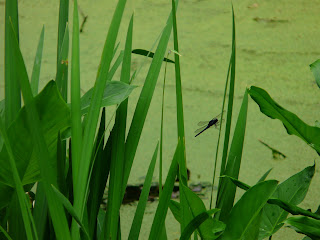Jug Bay, Upper Marlboro, MD, June 15, 2011: Mount Airy Clay Breakers Garden Club and guests took an ecological tour of Jug Bay at Patuxent River Park. The group observed the effects of global warming, the efforts at restoring the marsh and river banks, and wildlife along the river banks and also learned of the history of human habitation along the river.





 Osprey now thrive along the Patuxent. This nest is observed around the clock by a solar powered camera:
Osprey now thrive along the Patuxent. This nest is observed around the clock by a solar powered camera: The park maintains a webcam of another osprey nest:
The park maintains a webcam of another osprey nest:Video streaming by UstreamIf you click on this photo to enlarge it, you can see that the osprey is carrying a freshly caught fish:

 Looking north toward Mount Calvert (c. 1780):
Looking north toward Mount Calvert (c. 1780): By killing off thousands of resident Canada geese and fencing the others away from the shore line, Patuxent River Park has been able to re-establish wild along the river banks. Here a team of three young women head out to fence a section of shoreline:
By killing off thousands of resident Canada geese and fencing the others away from the shore line, Patuxent River Park has been able to re-establish wild along the river banks. Here a team of three young women head out to fence a section of shoreline:
 Red-winged Blackbirds are frequent in the marsh:
Red-winged Blackbirds are frequent in the marsh: Here a Marsh Wren emerges from his nest built on a cattail:
Here a Marsh Wren emerges from his nest built on a cattail: The circle in the middle of the river was where the Chesapeake Beach Railway bridge turned to permit river traffic; from 1900 to 1935 this railway took Washingtonians to and from the Chesapeake Beach resorts.
The circle in the middle of the river was where the Chesapeake Beach Railway bridge turned to permit river traffic; from 1900 to 1935 this railway took Washingtonians to and from the Chesapeake Beach resorts. A beaver used this duck blind as the local of his lodge:
A beaver used this duck blind as the local of his lodge:
 Disembarking; our photographer was the last one aboard:
Disembarking; our photographer was the last one aboard:
 Bee balm:
Bee balm:
and thread leaved tickseed:

Butterflies on milkweed and on swamp milkweed:


After the boat trip, some of us enjoyed a guided tour of the Patuxent Rural Life Museums. Our first stop was Duckett Cabin (c. 1880), which is a one room tenant farmer's cabin with a loft.
 We all went inside the cabin and left by the back door:
We all went inside the cabin and left by the back door:

The loft was one room up a steep stairs; left is lit by the camera; right is the floorboards without extra light:


This Sears, Roebuck and Company 1923 Simplex Section House was originally purchased for $443 and had three rooms with no plumbing and no electricity.
 A bedroom and a kitchen are side by side behind the front parlor:
A bedroom and a kitchen are side by side behind the front parlor:

There was also a blacksmith's shop, a farrier and tack shop, a general museum with various 19th century items and a tobacco farming museum. In the 18th and 19th century, tobacco was packed in hogshead barrel for shipment overseas. Below left is a tobacco press (c. 1900). The barrels were rolled down rolling roads to the river landings where they were loaded aboard ships. Later, tobacco was piled atop a basket and held together with a second basket on top (right):


On our way out, we took a side trip to Mount Calvert, where the plantation house is being stabilized and there are ongoing archeological digs. Inside is a very good museum on the history of the site.
 There have been over 6,000 years of human habitation at this site. The area was first deeded to Phillip Calvert, the 5th Proprietary Governor of Maryland. The colonial government established a town here in the late 17th century. The town was renamed Charles Town when it became county seat of the newly formed Prince George's County. When the county seat was moved upriver to Upper Marlboro, the town declined and eventually became a tobacco plantation.
There have been over 6,000 years of human habitation at this site. The area was first deeded to Phillip Calvert, the 5th Proprietary Governor of Maryland. The colonial government established a town here in the late 17th century. The town was renamed Charles Town when it became county seat of the newly formed Prince George's County. When the county seat was moved upriver to Upper Marlboro, the town declined and eventually became a tobacco plantation.

This is the view of Jug Bay looking south from Mount Calvert:
 Along Mount Calvert Road, there were alpaca farms:
Along Mount Calvert Road, there were alpaca farms:


--Photos by Bill Dean


















































